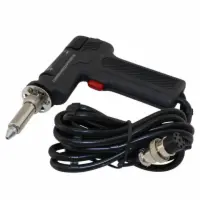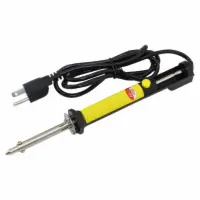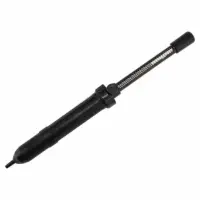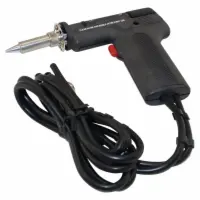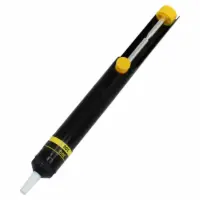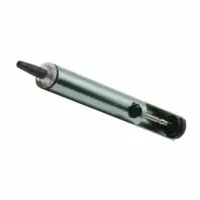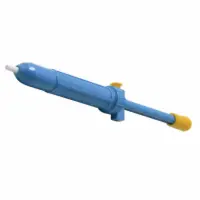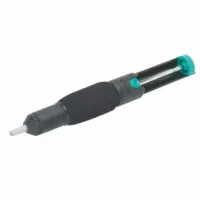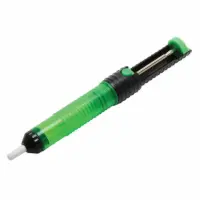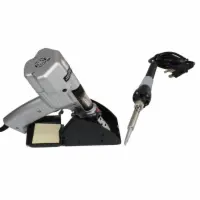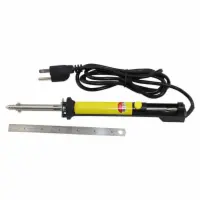A solder sucker is a type of handheld, syringe-like desoldering tool that uses a vacuum suction pump to remove melted solder. Solder suckers go by many names, including desoldering pump, solder vacuum, and solder remover.
A desoldering iron or desoldering gun is a type of powered desoldering pump that both heats and suctions the solder away. Whereas solder suckers require a soldering iron or hot air gun to melt the solder first, desoldering irons make it possible to remove solder without the need for additional heating tools.
Solder suckers, desoldering irons, and solder wicks are all excellent options for solder removal.
Solder wicks, also known as desoldering braids, rely on capillary action to wick away melted solder. They are the most economical desoldering option but can be time-consuming and require some practice to be effective. Desoldering wicks also have a one-time use, so you have to buy more once a spool runs out.
Solder suckers (desoldering pumps) are the second most cost-effective way to remove solder. However, like solder wicks, a soldering iron is needed to heat and melt the solder first, which requires two-handed operation and swift coordination. Keep in mind that solder suckers may not be ideal for desoldering SMD components, because the pump might suction away the surface-mount components along with the solder!
Desoldering guns and irons (powered desoldering pumps) are the most costly desoldering option—but not by much. While solder wicks eventually run out and need to be replaced, desoldering irons (like solder suckers) are reusable, saving you money in the long run. They’re also more durable than solder suckers. Most importantly, desoldering irons make it possible to desolder one-handed, which is especially critical for SMD desoldering where you might need to hold down components with another tool while suctioning the solder.
Flux is essential for any kind of desoldering you do, whether you’re using a solder wick or powered desoldering iron. Flux improves the wettability of the solder, making it easier to suction away.
A soldering iron or hot air gun is needed to melt the solder. If you are using a desoldering iron, you do not need a separate heating tool. Wait until the iron reaches a high enough temperature to melt solder. If lead solder, the melting point is likely 183°C or 361°F. If lead-free, then the melting point will be higher, around 221°C or 430°F.
If using a soldering iron, opt for a chisel or hoof tip, which spreads the heat more uniformly. Ideally, the soldering tip should be around the same size as the pad being soldered, if not slightly smaller; a good rule of thumb is to pick a tip that’s 60% the size of the pad or area being soldered.
Even if you’re using a desoldering iron, we recommend tinning the tip for better heat transfer.
If using a solder sucker, push down the plunger so the pump is ready to provide vacuum suction when you pull the trigger. Some desoldering pumps require you to hold down the trigger until you are ready to release. Practice using the solder sucker for a couple minutes to get a feel for the tool.
As you melt the solder with the soldering iron, hold the desoldering pump at a slight angle over the lead and solder joint so it’s just above the soldering iron tip, but not touching it. If using a desoldering iron, place the nozzle directly over the lead and joint.
The solder now melted, remove the soldering iron and swiftly position the solder sucker so it’s directly above the solder you’re removing. Quickly suction away the solder by clicking the release button on the side of the pump. You may need to do this a couple of times to remove all or most of the solder.
Important note for desoldering SMDs: Surface-mount components may be suctioned away along with the solder if you’re not careful! If you plan to use a solder sucker to desolder SMDs, take extra precautions by holding down the components with a set of tweezers while the solder is being suctioned. You may want to melt the solder, quickly remove the SMDs from the PCB, and then suction away the solder.

